To identify surges in your home, pay attention to flickering lights, frequently restarting devices, or abnormal meter readings. Surges cause approximately $26 billion in damages annually, and installing surge protectors is an effective preventive measure.

Basic Definition of Surge
A surge is defined as a voltage exceeding the household standard of 120 volts, which can cause significant damage to electronic devices. According to the National Electrical Manufacturers Association (NEMA), surges in the United States result in about $26 billion in damages annually.
Small surges caused by the switching of large appliances can gradually damage electronic components. For instance, the compressor of a refrigerator or air conditioner might cause a 20-volt surge.
Unlike continuous voltage conditions, transient voltages typically last less than a millisecond. According to the Electrical Safety Foundation International (ESFI), 60-80% of surges originate from within the home.
Industry expert Mike Holmes states, "Every modern home should be equipped with surge protectors because they provide a cost-effective way to protect valuable electronic devices." High-quality surge protectors cost between $20 and $100 and can prevent thousands of dollars in damages.
Choose devices rated for "clamping voltage" – the lower the clamping voltage, the better the protection. A clamping voltage of 330 volts is better than 400 volts. The "joule rating" indicates energy absorption capacity, with higher joule ratings providing better protection.
Signs of Appliance Failure in the Home
According to the U.S. Energy Information Administration, surges account for 20% of appliance failures. A refrigerator compressor may cause a 20-volt surge, significantly shortening the device's lifespan.
The IEEE notes that device noise is an early warning signal of electrical system abnormalities. Televisions often emit sharp sounds after being affected by surges. Consumer Reports data shows that over 30% of home appliance fires are caused by surges.
Technical experts recommend checking power lines and surge protectors when there are display anomalies. Computer monitors often show problems after surges.
Surges can damage internal components of appliances, such as burning out circuit boards or causing capacitors to explode. According to the home appliance repair industry, surge-related repair costs average $200.
An unexplained increase in electricity bills may be caused by surges. Energy experts suggest regularly checking appliances and power lines to ensure there are no surge problems.
Warning Signals of Abnormal Lighting
Instant voltage fluctuations cause changes in bulb brightness, especially when using high-power appliances such as air conditioners or microwaves. The Institute of Electrical and Electronics Engineers (IEEE) states that frequent voltage fluctuations can damage lighting systems.
Typically, when current increases, voltage decreases, causing bulbs to dim. According to the U.S. National Energy Technology Laboratory, during peak electricity usage, voltage drops can cause deviations of up to 10%.
When surges occur frequently, the flickering frequency of bulbs can significantly increase, reaching dozens of times per minute.
Surges can cause internal components of lighting fixtures to overheat, raising the external temperature of the fixtures. A temperature rise exceeding 5 degrees Celsius may be caused by surges. Noted electrical expert John Smith points out that overheating fixtures increase the risk of fire.
If bulbs in multiple rooms of a home flicker or dim simultaneously, it indicates that surges may be affecting the entire grid system. The U.S. Energy Information Administration (EIA) recommends contacting the power company immediately to check the grid status in such cases.

Abnormal Performance of Meters and Outlets
If the meter shows a sudden increase in electricity consumption without any change in actual usage, it may be caused by surges. According to the U.S. Energy Information Administration (EIA), abnormal meter readings can lead to a 20-30% increase in monthly electricity bills.
An outlet temperature exceeding 40 degrees Celsius may pose a fire risk. The Consumer Safety Commission (CPSC) recommends regularly checking outlet temperatures to ensure household electrical safety.
If you see sparks or hear noise every time you plug in or unplug an appliance, it indicates poor electrical contact inside the outlet, possibly due to surge damage to internal components. According to home appliance repair expert John Smith, this situation requires immediate replacement of the outlet to prevent further damage.
Black or burnt marks on outlet covers are the result of overheating or short-circuiting caused by surges. The National Fire Protection Association (NFPA) reports that outlet issues are one of the main causes of household fires, causing thousands of fire accidents annually.
If the meter trips multiple times within a short period, it usually indicates frequent surges. Energy expert Mike Holmes recommends installing surge protectors to reduce meter tripping frequency and protect the household power system.
Preventive and Response Measures
High-quality surge protectors, costing between $20 and $100, absorb sudden voltage spikes to protect connected devices. The National Electrical Manufacturers Association (NEMA) recommends that every household install at least one surge protector to reduce surge damage.
Check the household electrical system quarterly to ensure there are no aging or damaged wires. The Electrical Safety Foundation International (ESFI) points out that aging wires are a primary cause of surge-induced fires, causing thousands of fire accidents annually.
During thunderstorms, lightning can cause strong surges. In such cases, turning off and unplugging high-power appliances like air conditioners, washing machines, and dryers can effectively reduce the risk of damage.
UPS devices not only provide temporary power support during outages but also filter and stabilize voltage fluctuations. Information technology experts recommend configuring UPS devices for critical equipment like computers and servers to prevent data loss and hardware damage.
Older electrical systems are more susceptible to surges. Regularly upgrading electrical systems, especially replacing old circuit breakers and fuses, can improve overall protection. According to power company data, upgrading electrical systems costs about $2,000 to $5,000 but can reduce long-term repair and replacement costs.
